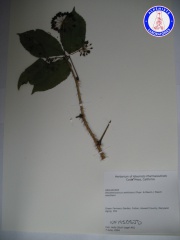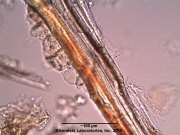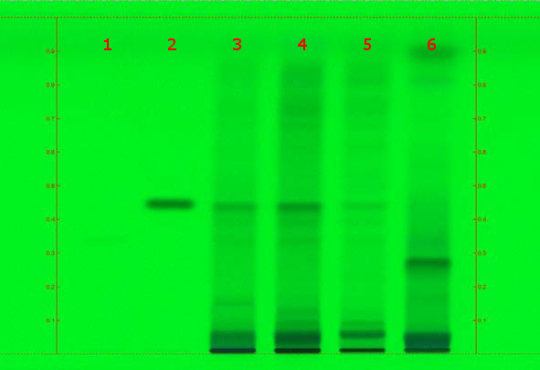Eleutherococcus senticosus (root bark)
m |
(fixed various common name errors and and italicized latin names. Need original submitter for this HPTLC to fix details) |
||
| Line 36: | Line 36: | ||
| companyURL=http://www.camag.com/index.php | | companyURL=http://www.camag.com/index.php | ||
| mainimage=Camag-eleuthero-1-d-uv254.png | | mainimage=Camag-eleuthero-1-d-uv254.png | ||
| − | | caption1= | + | | caption1=Eleuthero HPTLC ID - Developed, UV 254 nm |
| − | | description= | + | | description=Eleuthero (root) (''Eleutherococcus senticosus'') |
| image2=Camag-eleuthero-1-H2SO4-whiteRT.png | | image2=Camag-eleuthero-1-H2SO4-whiteRT.png | ||
| caption2=Black Cohosh HPTLC ID - Sulfuric Acid Reagent, white RT | | caption2=Black Cohosh HPTLC ID - Sulfuric Acid Reagent, white RT | ||
| Line 76: | Line 76: | ||
at Rf=0.53 and Rf=0.28 are detected. | at Rf=0.53 and Rf=0.28 are detected. | ||
| − | Further methodology available here, in [http://www.ahpa.org/portals/0/pdfs/Eleuthero_ID_Method.pdf Identification method of '' | + | Further methodology available here, in [http://www.ahpa.org/portals/0/pdfs/Eleuthero_ID_Method.pdf Identification method of ''Eleutherococcus senticosus'' by HPTLC]. |
| }} | | }} | ||
=Other Points of Interest= | =Other Points of Interest= | ||
| Line 88: | Line 88: | ||
}} | }} | ||
| − | ==AHPA Practical: Identification and Quality Control of Eleuthero (''Eleutherococcus senticosus'') | + | ==AHPA Practical: Identification and Quality Control of Eleuthero (root) (''Eleutherococcus senticosus'')== |
[[Category:AHPA Practicals]] | [[Category:AHPA Practicals]] | ||
[[File:AHPA Logo.gif|right|150x75px|link=http://www.ahpa.org/]] | [[File:AHPA Logo.gif|right|150x75px|link=http://www.ahpa.org/]] | ||
===Introduction=== | ===Introduction=== | ||
| − | Neonatal androgenization was associated with the ingestion of a product during pregnancy, which was labeled as containing Siberian ginseng (1). The image on the product was of an actual ginseng plant (Panax spp.) not ''Eleutherococcus senticosus'' (formerly sometimes referred to as Siberian ginseng) and analysis of the product indicated that neither eleuthero nor ginseng compounds were present, but that Chinese silk vine (''Periploca sepium'') was (2). | + | Neonatal androgenization was associated with the ingestion of a product during pregnancy, which was labeled as containing Siberian ginseng (1). The image on the product was of an actual ginseng plant (''Panax spp.'') not ''Eleutherococcus senticosus'' (formerly sometimes referred to as Siberian ginseng) and analysis of the product indicated that neither eleuthero nor ginseng compounds were present, but that Chinese silk vine (''Periploca sepium'') was (2). |
===Methods of Analysis=== | ===Methods of Analysis=== | ||
| Line 99: | Line 99: | ||
[http://www.ncbi.nlm.nih.gov/pubmed/15688958?ordinalpos=59&itool=EntrezSystem2.PEntrez.Pubmed.Pubmed_ResultsPanel.Pubmed_DefaultReportPanel.Pubmed_RVDocSum Quality control of roots of ''Eleutherococcus senticosus'' by HPLC] | [http://www.ncbi.nlm.nih.gov/pubmed/15688958?ordinalpos=59&itool=EntrezSystem2.PEntrez.Pubmed.Pubmed_ResultsPanel.Pubmed_DefaultReportPanel.Pubmed_RVDocSum Quality control of roots of ''Eleutherococcus senticosus'' by HPLC] | ||
| − | [http://www.ahpa.org/portals/0/pdfs/Eleuthero_ID_Method.pdf Identification method of '' | + | [http://www.ahpa.org/portals/0/pdfs/Eleuthero_ID_Method.pdf Identification method of ''Eleutherococcus senticosus'' by HPTLC] |
===References=== | ===References=== | ||
Revision as of 20:53, 16 October 2012
Contents |
Introduction
Introduction from Wikipedia, the free encyclopedia (http://en.wikipedia.org/wiki/Eleutherococcus_senticosus, retrieved 02/27/2012).
Eleutherococcus senticosus (formerly Acanthopanax senticosus) is a species of small, woody shrub in the family Araliaceae native to Northeastern Asia. It is often colloquially referred to as Siberian Ginseng, eleuthero or Ciwujia, and is sometimes shortened to E. senticosus in medical literature. E. senticosus has been studied as an adaptogen, and has a history of use in Chinese medicine, where it is known as cì wǔ jiā (刺五加).
The herb grows in mixed and coniferous mountain forests, forming low undergrowth or is found in groups in thickets and edges. E. senticosus is sometimes found in oak groves at the foot of cliffs, very rarely in high forest riparian woodland. Its native habitat is East Asia, China, Japan, and Russia. E. senticosus is broadly tolerant of soils, growing in sandy, loamy, and heavy clay soils with acid, neutral, or alkaline chemistry and including soils of low nutritional value. It can tolerate sun or dappled shade and some degree of pollution. E. senticosus is a deciduous shrub growing to 2m at a slow rate. It is hardy to zone 3. It flowers in July in most habitats. The flowers are hermaphroditic and are pollinated by insects.
The quoted text in this section was licensed for use under the Creative Commons ShareAlike License, version 3.0: http://creativecommons.org/licenses/by-sa/3.0/
Macroscopic Entries
|
Microscopic Entries
|
HPTLC Entries
|
Eleuthero (root) (Eleutherococcus senticosus) Lane Assignments Lanes, from left to right (Track, Volume, Sample): (2 μL of references, 10 μL of test solutions)
Reference Sample(s) Reference: Dissolve 1 mg of eleutheroside B and 1 mg of eleutheroside E individually in 1.5 mL of ethanol-water (1:1). Stationary Phase Stationary phase, i.e. Silica gel 60, F254 Mobile Phase Chloroform, methanol, water 70:30:4 (v/v/v) Sample Preparation Method Sample: Mix 1 g of powdered sample with 5 mL of ethanol-water (1:1) and sonicate for 10 minutes, then centrifuge or filter the solutions and use the supernatants / filtrates as test solutions Sulfuric Acid Reagent: Preparation: 20 mL of sulfuric acid are mixed with 180 mL of ice-cooled methanol Detection Method UV/Vis, Sulfuric Acid Reagent Use: Dip (time 0, speed 5), heat at 100°C for 5 min Other Notes System suitability test: After derivatization the fingerprint of the test solution shows a zone corresponding to eleutheroside B and another zone directly below. These two zones appear as two distinct bands, compare lane 2 with lanes 3, 4 and lane 1 with corresponding feature in 3, 4. An arrow marking the distinct bands appears in the illustration in further methodology, below. Identification: Compare result under UV 254 nm and white RT with reference images in Image Comparison Viewer. The fingerprint of the test solution is similar to that of the corresponding botanical reference sample. Additional weak zones may be present. Eleuthero: The chromatogram of the test solution shows bands corresponding to eleutherosides E (Rf 0.34) and B (Rf 0.45), and two very strong bands near the application zone. Additional brownish-purple zones are seen between eleutheroside E and the solvent front. Periploca sepium Adulteration: No band corresponding to eleutheroside B is seen, but strong brown bands at Rf=0.53 and Rf=0.28 are detected. Further methodology available here, in Identification method of Eleutherococcus senticosus by HPTLC. Source: AHPA Practical, CAMAG HPTLC [3] |
Other Points of Interest
Eleuthero (root bark) (Eleutherococcus senticosus)
General Characteristics AHPA recommends in its Known Adulterants list that appropriate steps be taken to assure that this raw material is free of the noted adulterant. Contact AHPA for additional information regarding relevant analytical methods or follow this link for more information.
Reported Adulterants Periploca sepium root.
Source: AHPA Known Adulterants [4]
AHPA Practical: Identification and Quality Control of Eleuthero (root) (Eleutherococcus senticosus)
Introduction
Neonatal androgenization was associated with the ingestion of a product during pregnancy, which was labeled as containing Siberian ginseng (1). The image on the product was of an actual ginseng plant (Panax spp.) not Eleutherococcus senticosus (formerly sometimes referred to as Siberian ginseng) and analysis of the product indicated that neither eleuthero nor ginseng compounds were present, but that Chinese silk vine (Periploca sepium) was (2).
Methods of Analysis
Quality control of roots of Eleutherococcus senticosus by HPLC
Identification method of Eleutherococcus senticosus by HPTLC
References
- Koren G et al. Maternal ginseng use associated with neonatal androgenization. Journal of the American Medical Association, 1990, 264:1866.
- Awang DV. Maternal use of ginseng and neonatal androgenization. Journal of the American Medical Association, 1991, 264:2865.
Additional Information
Awang D. Siberian ginseng toxicity may be case of mistaken identity. CMAJ. 1996 Nov 1;155(9):1237.
Cite error: <ref> tags exist, but no <references/> tag was found






